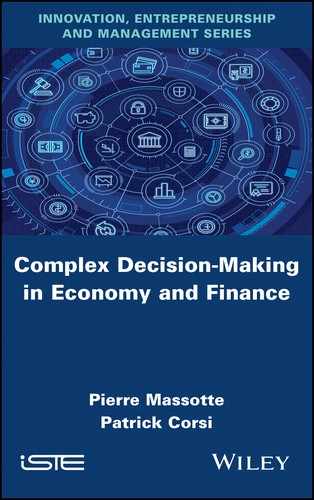Book Description
Pertinent to modern industry, administration, finance and society, the most pressing issue for firms today is how to reapproach the way we think and work in business.
With topics ranging from improving productivity and coaxing economic growth after periods of market inactivity, Complex Decision-Making in Economy and Finance offers pragmatic solutions for dealing with the critical levels of disorder and chaos that have developed throughout the modern age.
This book examines how to design complex products and systems, the benefits of collective intelligence and self-organization, and the best methods for handling risks in problematic environments. It also analyzes crises and how to manage them. This book is of benefit to companies and public bodies with regards to saving assets, reviving fortunes and laying the groundwork for robust, sustainable societal dividends. Examples, case studies, practical hints and guidelines illustrate the topics, particularly in finance.
Table of Contents
- Cover
- Introduction: New Beginnings
- PART 1: Dealing with Complexity
- 1 Engineering Complexity within Present-Day Industrial Systems
- 2 Designing Complex Products and Services
- 3 Engineering and Complexity Theory: A Field Design Approach
- 4 Organizational Constraints and Complexity Theory: Modeling with Agents
- 5 Complexity and the Theory of Organizations: Implementation of Collective Intelligence
- 6 Complexity and the Theory of Organizations: The Notion of Collective Patterns
- 7 Complexity and Theory of Organizations: Structure and Architecture of an Enterprise
- 8 Complexity and the Theory of Organizations: Applications
- 9 Complexity and the Theory of Organizations: Complex Systems Reengineering
- 10 Evaluating and Measuring Complexity: The CINSYS Methodology
- 10.1. A brief overview of the CINSYS system
- 10.2. What can be found in a CINSYS model?
- 10.3. Functional analysis of the method: interpretation by the CINSYS symbolic and structural diagram
- 10.4. Illustration of the method
- 10.5. What are the advantages of using the method?
- 10.6. “The network metaphor” as the general application context of the method
- 10.7. Perspectives beyond the CINSYS method
- 10.8. Conclusion
- PART 2: Dealing with Risk in Complex Environments
- 11 Underlying Mechanisms in Finance
- 11.1. Introduction to finance theory and its evolution
- 11.2. What are the best candidates for the so-called econophysics?
- 11.3. Action plans in financial regulation and bank regulation: are they ok?
- 11.4. Back to physics and matter: their contribution
- 11.5. From matter up to living beings: how can big events be generated?
- 11.6. The evolution of an economic system – the problem of CRISIS
- 11.7. Role of complexity and diversity in Nature
- 11.8. Application: how should we proceed when faced with crises and financial crashes/crises?
- 11.9. Crisis as the end of an evolution
- 11.10. Collapse theory and modeling – a theory of the “end”
- 11.11. Design of financial products: the example of world interconnections
- 11.12. Conclusion
- 12 Physics and Social Networks: Domain Similarities
- 13 Managing Behavioral Risks: Uncertainty and Catastrophes
- 14 On Managing Risk in the Energy Domain: Conventional Problems Encountered
- 15 On Managing Risk in the Financial Domain
- 15.1. Taking about disasters – from risks to catastrophes in finance
- 15.2. An interesting approach: financial analysis of losses
- 15.3. When the drama occurs
- 15.4. How to conduct a risk consequence analysis process?
- 15.5. Conservatory measures: risk and diversification
- 15.6. An additional risk: the decline and inversion rate at the stock exchange
- 15.7. Concluding with additional risks of the shared economy
- 16 Why Current Tools Are Inadequate
- 16.1. On the shortcomings of current tools: risk and probability
- 16.2. A thematic illustration
- 16.3. What regularities?
- 16.4. Characteristics of rational expectations in economics
- 16.5. Risk characteristics in the industry
- 16.6. A philosophical summary: chance and necessity
- 16.7. The environment’s new challenge
- 17 How to Manage Crises?
- 18 Managing Crises in Finance and Other Domains
- 19 Technological, Monetary and Financial Crashes
- 11 Underlying Mechanisms in Finance
- Conclusion: Different Types of Crises
- List of Abbreviations
- References
- Index
- End User License Agreement
